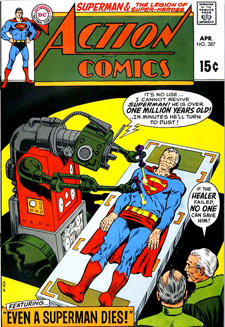 Even
A Superman Dies!
Even
A Superman Dies!
With Action Comics #387 (Apr 1970), writer Cary Bates brings
to a close his epic saga of the time-tossed, ancient Superman
in "Even A Superman Dies!"
We open in deep space in the 8020th century, where a "train"
of "ice-spheres" is drifting along connected by
a tether, each globe containing the body of an astronaut
frozen in suspended animation.
Coming across this eerie scene, the now-aged Superman reasons
the "ice-spheres" must be "part of an emergency
safety device to protect the astronauts from death in space!"
And so he sets about reviving them. Bored at the prospect
of using his heat vision, he opts for a more interesting
rescue, dragging the spheres through the melting rays of
a "rainbow sun."
Gloomy and listless, Superman thinks, "I'm just too
tired of doing my thing," which is interesting for
a number of reasons. First of all, because he's still spouting
70s slang after all those milennia, but also because he's
acting like a guy who's actually lived into the future,
as opposed to simply traveling to it. We know from the previous
installments that he journeyed from 1970 to the year 101,970
in a matter of seconds (though it aged him physically in
the process) but it's not clear here whether he's time-traveled
the rest of the way to the 8020th century or simply allowed
himself to age to that point (a caption says "This
is the year 801,970! And Superman has aged every year!").
If he really has slowly aged all those years, I can buy
his "tired of it all" attitude, but if he got
here through the time barrier, it's not justified; he should
still have the mind of a 30-something Superman even if he's
trapped in an older body.
At any rate, once the astronauts revive they barrage Superman
with questions ("Where have you been all this time?
Why did you disappear from Earth? How did you live so long?")
but now that he's in "cranky old curmudgeon" mode,
he just testily flies away without answering. He's still
not cranky enough to just leave them marooned, but he is
cranky enough to "rescue" them by disabling a
passing space ship with his heat vision so it will be forced
to land for repairs, and in the process discover and rescue
the astronauts.
"I've had it here!" he thinks, and speeds even
further into the future, this time arriving "one million
years ahead of 1970" (about where fashion is today)
to find the Earth a lifeless husk, in one of those wonderfully
subtle moments of "social relevance" for which
70s comics were so famous.
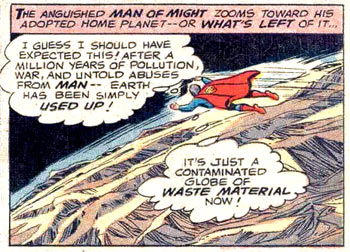
(Note from the editor: this issue's installment of "Sledghammer-to-the-Head
Social Commentary" is sponsored by the Sierra Club)
Coincidentally, a pair of ginormous robots is even now
arriving at what they call "Dead Planet 446" in
order to haul it away as junk. Labels on the robots show
they're from the "Galactic Sanitation Department,"
but Superman won't stand for it: "Contaminated or not,
Earth is still my planet...and I'm not going to see it demolished
for some 'Keep Space Beautiful" campaign!"
Flying inside the robots' brains, he rewires them both
to emit positive charges, and since like charges repel,
they're shot away from each other -- and the Earth -- into
deep space. Then Superman sets about restoring the Earth
to its former glory, which involves (for some reason) sawing
it in half.
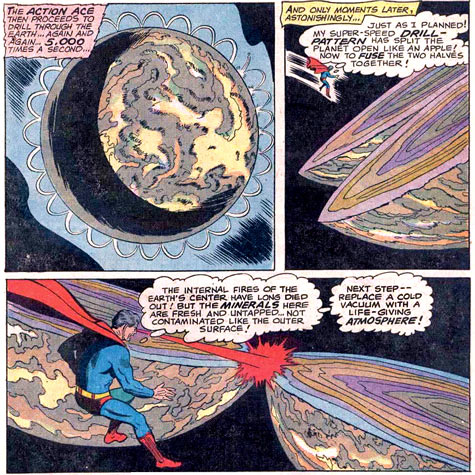
And then he's off to make the circuit of "a dozen
planets", borrowing from each one a giant cloud of
gasses to serve as the atmosphere of the restored Earth.
"Borrows" how, you ask? By sucking them into his
lungs of course, in one of those physics-defying stunts
Superman is so famous for.
Of course the problem is that without "the internal
fires of the Earth's center," there will be no magnetic
field around the Earth to prevent that new atmosphere from
being blown away by the solar winds, but we can't be bothered
with details like that, now can we? Not when there's a world
to populate.
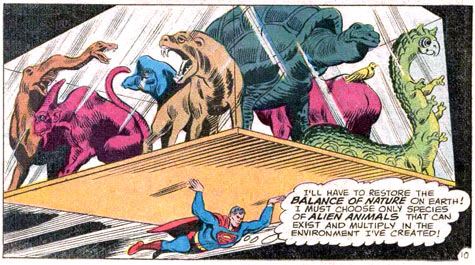
Nice that the animals can "exist and multiply"
on Earth, but did he check to see whether they could get
along with each other and not just wipe each other out within
24 hours? Also, I'm no expert on animal husbandry, but ideally
wouldn't you want at least two examples of every species,
a male and a female?
If Superman hasn't read the story of Noah's Ark, though,
at least he's read the story of Adam and Eve, so now it's
off to another planet to abduct a pair of humans...
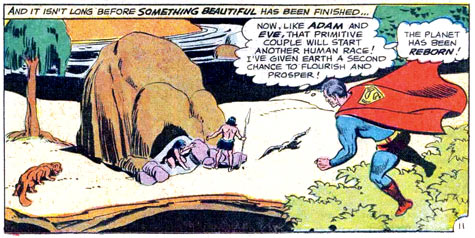
Is it just me, or is it a little callous of Superman to
move these people from their home world without so much
as a "by your leave"? Also, it's a pretty big
roll of the dice to bet the propagation of the species on
a single couple. What happens if one of those transplanted
creatures eats them for dinner? One of them looks ready
to pounce even in this picture.
Anyway, having amused himself by playing God (and beating
the old "Genesis" record by five days!), Superman
heads off for space with nothing to look forward to but
"an eternity of boredom." Until, that is, a small,
harpoon-shaped spacecraft deals him a lethal stab in the
back.
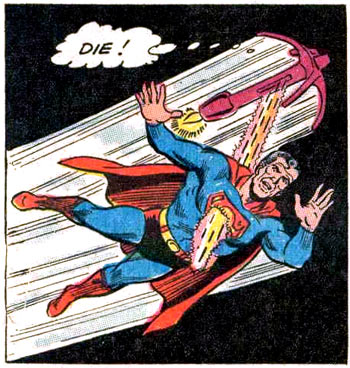
Now a flashback takes us back 10,000 centuries to the year
2000 (!), where learn that a withered old Lex Luthor never
accepted the conventional wisdom that Superman was dead.
"There was no body," he reasons, "no will...no
solid evidence of death!" Unwilling to let himself
die without being absolutely sure of his enemy's fate, Luthor
transferred his "psyche-energy" into a "killer
drone" (the harpoon ship we saw above) at the moment
of his death. Powered by Luthor's life energy, the drone
flew through space for centuries, stopping occasionally
to "refuel" itself with the evil life force of
executed villains from countless worlds.
"We can convert our store of pure evil energy,"
the Luthor-drone is shown thinking, "into the most
destructive weapon ever known in the Universe" with
the single purpose of killing the Man of Steel, a goal it
appears to have finally achieved after a million years of
searching.
As fate would have it, though, Superman's near-lifeless
form is discovered by a robotic healer that restores him
to life, much to his disgust.
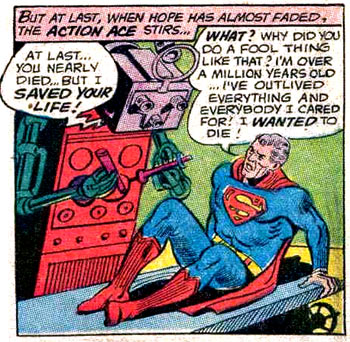
Furious at having been spared a quick death, Superman flies
away, into the path of the massive Magnor Comet. "It
will disintegrate everything in its path," warns the
healer, "even you!" But Superman just thinks,
"that'll suit me fine!"
The killer drone spots him and closes in for a second attack,
but then the comet hits and the drone is disintegrated.
Not so Superman, who's merely "whisked along at an
unimaginable velocity" by the comet. Swept through
the time barrier to the end of time, Superman blacks out
and awakens...as a baby. Or so it seems. Then his consciousness
fades in and out through the highlights of his life. Maybe
it'll make more sense to you the way Cary Bates wrote it:
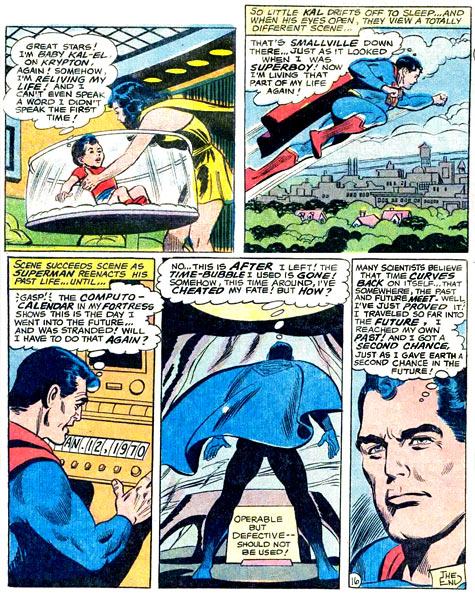
Or maybe not. Anyway, Superman is returned to 1970, just
moments after he left Earth, and everything's just swell
again.
Even for a story as outlandish as this one, that's a pretty
nutty ending. It doesn't add up: Time can't have "gone
full circle," since we saw the history tapes of Lois,
Jimmy and Perry's lives in a world with no Superman, a history
which will never happen now that he's back. So at most what
we've got here is a second timeline, an alternate reality.
Bates' "resolution" also doesn't solve much of
anything, as he leaves the hero worse off than he started,
with the story's most disturbing issues unresolved. Remember
how Superman said he was "tired of doing his thing?"
How he was so bored of his very existence that he cussed
out the healer for not letting him die? How he was ready
to break his own code and commit suicide (an act which Bates
himself -- in a later story -- says is a violation of his
no-kill oath)? Well here at story's end he still remembers
everything that happened, every year he lived, every experience
he had as an old man. Which means even though he's lost
the wrinkles and gray hair, he's even older now than he
was in the year One Million. So what makes him so darned
happy about enduring a second eternity, aside from the knowledge
that a tiny slice of it will be spent in the company of
his friends? If anything, this guy should be more depressed
than ever. I know I am.
In all, I'd rate this one a miss, but a well-intentioned
one. Bates gets bonus points for trying to do something
memorable and interesting at a time when the character was
running out of steam (the Julie Schwartz revamp was by now
just months away) and Curt Swan and George Roussos serve
up solid art, but the "hocus pocus" ending is
a major letdown, and the general sense of mounting despair
and depression is in no way relieved by that trite denouement.
I did kind of like the "Superman as Creator"
bit, however lousy the science behind it, but ultimately,
the covers are the best part of the whole epic, which was
not all that uncommon a thing back in the day. Trust me,
I remember. I'm old.








